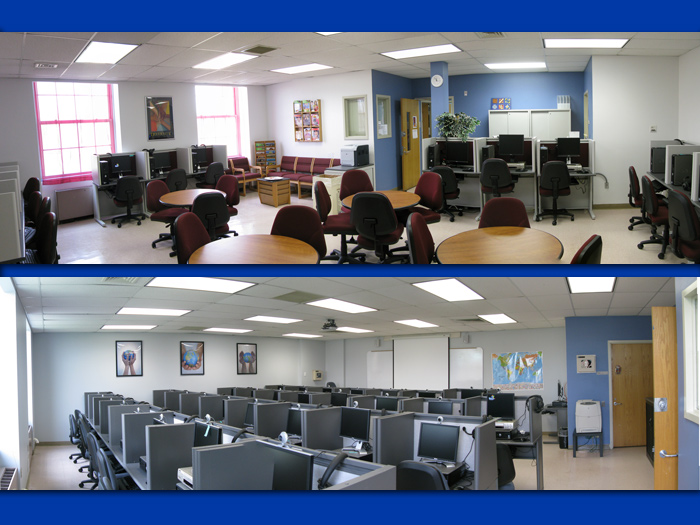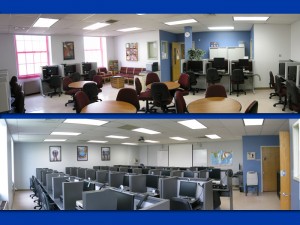The Department of Modern Languages at the College of Staten Island recently implemented new oral OWL Testing Software. The platform is now being used by more than 800 CSI students for all proficiency levels of French, Spanish, and Italian. There are also plans for the Department to employ the software for the assessment of Mandarin Chinese and Basic Arabic later this semester.
Commenting on the choice of the new platform, Valeria Belmonti, Director of CSI’s Modern Languages Media Center, says, “The Media Center was looking for a user-friendly application to provide enough flexibility for faculty to customize oral exams according to languages and levels. Another important criterion was to find software that includes a built-in assessment module that would allow faculty to grade oral exams on the same platform used by students to record oral exams. Training efficiencies are quickly realized by having students and professors using the same software. We also needed an online application that would allow faculty to grade exams on and off campus.”
What does this platform have that old evaluation methods didn’t? According to Belmonti, “OWL allows us to integrate multimedia into the questions, time students’ answers, randomize questions in various ways, and apply different grading rubrics and/or points systems to different sections of an oral exam. OWL’s ability to generate reports also makes it easy for the Department to record and analyze the results of oral exams. [In addition] the OWL built-in audio recorder has particularly streamlined the process of oral exams, since students now access the questions and record their answers using the same interface.
Gerry Milligan, Acting Chair of the Modern Languages Department, Assistant Professor of Italian, and Italian Studies Coordinator, states, “The software is useful for faculty because it allows for swift oral exams [which is particularly useful when a large number of students require an oral exam at any given time]…Also, the software allows faculty to create an electronic portfolio of students’ verbal skills at critical moments in their training. This is particularly useful for outcomes assessment because the portfolios allow faculty to determine students’ performance at each level of our language sequence. Finally, the possibility of giving the students oral feedback is fundamental to error correction of pronunciation, a central issue in second language acquisition.”
As for the benefits to students, Milligan points out that “the software, unlike the online activities provided by the students’ workbooks, allows students to create a portfolio of verbal recordings. They can practice their verbal skills and even receive recorded oral feedback from the instructor. They can also listen to their previous recordings in order to practice their speech as well as monitor their own progress. Ultimately, we are creating superior language learners and, in particular, better second language speakers.”
Professor of French and French Program Coordinator Kathryn Talarico notes that her students “seem to like the ability to see immediate results and get oral feedback from their instructor. Some students have said that they like the pressure of being timed in their answers since it forces them to think on their feet and to respond quickly. Since language study is all about communication, a serious program that tests oral skills (listening and speaking) makes learning a language more authentic.”
Regarding her opinion as an educator, Talarico states that, beyond the platform’s ease of use, “I have found that we can do more intensive oral testing and training of students, something that really isn’t done with any regularity or consistency at other colleges around the country. In French, we use the software for both testing and for systematic training of students’ pronunciation. The software allows instructors to leave oral feedback from students, so, for instance, if they mispronounce something or make a mechanical error, the instructor can record the correct answer. Students can get their grades with both oral and written feedback a few days after the test or exercise is over.
Another faculty user, Sarah Pollack, Assistant Professor of Spanish and the Coordinator of the Spanish Program, says that when it comes to her students “Listening and speaking are probably the hardest language skills to acquire in the classroom. By incorporating this software into the curriculum, students will be afforded more opportunities to practice and be evaluated on these fundamental areas of communication. I also agree with Professor Talarico that the ability to leave oral feedback for students is incredibly beneficial, as they can get immediate, individualized feedback on their speaking–something that is difficult to do effectively in the classroom setting.”
Pollack also appreciates the flexibility of the software and notes that “the OWL platform allows us to create oral exercises that are close to real-life situations, and [this allows] students to practice language in a more authentic setting.” In addition, she says, “We can now efficiently create exercises and exams that evaluate all of our students in a creative and systematic fashion. My hope is that we can slowly increase our use of OWL in the Spanish Program until we are able to give as much weight to oral work as to written work.”

















